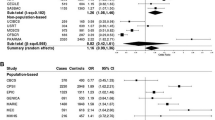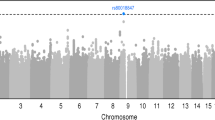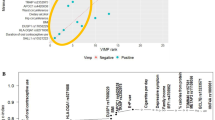Abstract
Purpose
Statins have been postulated to have chemopreventive activity against breast cancer. We evaluated whether germline genetic polymorphisms modified the relationship between statins and breast cancer risk using data from the Women’s Health Initiative. We evaluated these interactions using both candidate gene and agnostic genome-wide approaches.
Methods
To identify candidate gene–statin interactions, we tested interactions between 22 SNPS in nine candidate genes implicated in the effect of statins on lipid metabolism in 1687 cases and 1687 controls. We then evaluated statin use interaction with the remaining 30,380 SNPs available in this sample from the CGEMS GWAS study.
Results
After adjusting for multiple comparisons, no SNP interactions with statin usage and risk of breast cancer were statistically significant in either the candidate genes or genome-wide approaches.
Conclusions
We found no evidence of SNP interactions with statin usage for breast cancer risk in a population of 3374 individuals. These results suggest that genome-wide common genetic variants do not moderate the association between statin usage and breast cancer in the population of women in the Women’s Health Initiative.

Similar content being viewed by others
References
Mann D, Reynolds K, Smith D, Muntner P (2008) Trends in statin use and low-density lipoprotein cholesterol levels among US adults: impact of the 2001 National Cholesterol Education Program guidelines. Ann Pharmacother 42(9):1208–1215
Duncan RE, El-Sohemy A, Archer MC (2005) Statins and cancer development. Cancer Epidemiol Prev Biomark 14(8):1897–1898
Liao JK (2002) Isoprenoids as mediators of the biological effects of statins. J Clin Investig 110(3):285–288
Agarwal B, Halmos B, Feoktistov AS, Protiva P, Ramey WG, Chen M, Pothoulakis C, Lamont JT, Holt PR (2002) Mechanism of lovastatin-induced apoptosis in intestinal epithelial cells. Carcinogenesis 23(3):521–528
Yasuda Y, Shimizu M, Shirakami Y, Sakai H, Kubota M, Hata K, Hirose Y, Tsurumi H, Tanaka T, Moriwaki H (2010) Pitavastatin inhibits azoxymethane-induced colonic preneoplastic lesions in C57BL/KsJ-db/db obese mice. Cancer Sci 101(7):1701–1707
Postmus I, Trompet S, Deshmukh HA, Barnes MR, Li X, Warren HR, Chasman DI, Zhou K, Arsenault BJ, Donnelly LA, Wiggins KL, Avery CL, Griffin P, Feng Q, Taylor KD, Li G, Evans DS, Smith AV, de Keyser CE, Johnson AD, de Craen AJ, Stott DJ, Buckley BM, Ford I, Westendorp RG, Slagboom PE, Sattar N, Munroe PB, Sever P, Poulter N, Stanton A, Shields DC, O’Brien E, Shaw-Hawkins S, Chen YD, Nickerson DA, Smith JD, Dube MP, Boekholdt SM, Hovingh GK, Kastelein JJ, McKeigue PM, Betteridge J, Neil A, Durrington PN, Doney A, Carr F, Morris A, McCarthy MI, Groop L, Ahlqvist E, Welcome Trust Case Control C, Bis JC, Rice K, Smith NL, Lumley T, Whitsel EA, Sturmer T, Boerwinkle E, Ngwa JS, O’Donnell CJ, Vasan RS, Wei WQ, Wilke RA, Liu CT, Sun F, Guo X, Heckbert SR, Post W, Sotoodehnia N, Arnold AM, Stafford JM, Ding J, Herrington DM, Kritchevsky SB, Eiriksdottir G, Launer LJ, Harris TB, Chu AY, Giulianini F, MacFadyen JG, Barratt BJ, Nyberg F, Stricker BH, Uitterlinden AG, Hofman A, Rivadeneira F, Emilsson V, Franco OH, Ridker PM, Gudnason V, Liu Y, Denny JC, Ballantyne CM, Rotter JI, Adrienne Cupples L, Psaty BM, Palmer CN, Tardif JC, Colhoun HM, Hitman G, Krauss RM, Wouter Jukema J, Caulfield MJ (2014) Pharmacogenetic meta-analysis of genome-wide association studies of LDL cholesterol response to statins. Nat commun 5:5068. doi:10.1038/ncomms6068
Iakoubova OA, Sabatine MS, Rowland CM, Tong CH, Catanese JJ, Ranade K, Simonsen KL, Kirchgessner TG, Cannon CP, Devlin JJ, Braunwald E (2008) Polymorphism in KIF6 gene and benefit from statins after acute coronary syndromes: results from the PROVE IT-TIMI 22 study. J Am Coll Cardiol 51(4):449–455
Link E, Parish S, Armitage J, Bowman L, Heath S, Matsuda F, Gut I, Lathrop M, Collins R (2008) SLCO1B1 variants and statin-induced myopathy—a genomewide study. N Engl J Med 359(8):789–799
Muck AO, Seeger H, Wallwiener D (2004) Inhibitory effect of statins on the proliferation of human breast cancer cells. Int J Clin Pharmacol Ther 42(12):695–700
Campbell MJ, Esserman LJ, Zhou Y, Shoemaker M, Lobo M, Borman E, Baehner F, Kumar AS, Adduci K, Marx C, Petricoin EF, Liotta LA, Winters M, Benz S, Benz CC (2006) Breast cancer growth prevention by statins. Cancer Res 66(17):8707–8714
Newman TB, Hulley SB (1996) Carcinogenicity of lipid-lowering drugs. JAMA 275(1):55–60
Blais L, Desgagne A, LeLorier J (2000) 3-Hydroxy-3-methylglutaryl coenzyme A reductase inhibitors and the risk of cancer: a nested case–control study. Arch Intern Med 160(15):2363–2368
Boudreau DM, Gardner JS, Malone KE, Heckbert SR, Blough DK, Daling JR (2004) The association between 3-hydroxy-3-methylglutaryl conenzyme a inhibitor use and breast carcinoma risk among postmenopausal women: a case–control study. Cancer 100(11):2308–2316
Coogan PF, Rosenberg L, Strom BL (2007) Statin use and the risk of 10 cancers. Epidemiology 18(2):213–219
Eliassen AH, Colditz GA, Rosner B, Willett WC, Hankinson SE (2005) Serum lipids, lipid-lowering drugs, and the risk of breast cancer. Arch Intern Med 165(19):2264–2271
Friis S, Poulsen AH, Johnsen SP, McLaughlin JK, Fryzek JP, Dalton SO, Sorensen HT, Olsen JH (2005) Cancer risk among statin users: a population-based cohort study. Int J Cancer 114(4):643–647
Graaf MR, Beiderbeck AB, Egberts AC, Richel DJ, Guchelaar HJ (2004) The risk of cancer in users of statins. J Clin Oncol 22(12):2388–2394
Kaye JA, Jick H (2004) Statin use and cancer risk in the general practice research database. Br J Cancer 90(3):635–637
Kaye JA, Meier CR, Walker AM, Jick H (2002) Statin use, hyperlipidaemia, and the risk of breast cancer. Br J Cancer 86(9):1436–1439
Setoguchi S, Glynn RJ, Avorn J, Mogun H, Schneeweiss S (2007) Statins and the risk of lung, breast, and colorectal cancer in the elderly. Circulation 115(1):27–33
Woditschka S, Habel LA, Udaltsova N, Friedman GD, Sieh W (2010) Lipophilic statin use and risk of breast cancer subtypes. Cancer Epidemiol Prev Biomark 19(10):2479–2487
Beck P, Wysowski DK, Downey W, Butler-Jones D (2003) Statin use and the risk of breast cancer. J Clin Epidemiol 56(3):280–285
Coogan PF, Rosenberg L, Palmer JR, Strom BL, Zauber AG, Shapiro S (2002) Statin use and the risk of breast and prostate cancer. Epidemiology 13(3):262–267
Eaton M, Eklof J, Beal JR, Sahmoun AE (2009) Statins and breast cancer in postmenopausal women without hormone therapy. Anticancer Res 29:5143–5148
Goldstein MR, Mascitelli L, Pezzetta F (2010) Might the widespread use of statin drugs explain the increase in prevalence of breast carcinoma in situ? Med Hypotheses 74(3):613–614
Sacks FM, Pfeffer MA, Moye LA, Rouleau JL, Rutherford JD, Cole TG, Brown L, Warnica JW, Arnold JM, Wun CC, Davis BR, Braunwald E (1996) The effect of pravastatin on coronary events after myocardial infarction in patients with average cholesterol levels. Cholesterol and recurrent events trial investigators. N Engl J Med 335(14):1001–1009
Shepherd J, Blauw GJ, Murphy MB, Bollen EL, Buckley BM, Cobbe SM, Ford I, Gaw A, Hyland M, Jukema JW, Kamper AM, Macfarlane PW, Meinders AE, Norrie J, Packard CJ, Perry IJ, Stott DJ, Sweeney BJ, Twomey C, Westendorp RG (2002) Pravastatin in elderly individuals at risk of vascular disease (PROSPER): a randomised controlled trial. Lancet 360(9346):1623–1630
Cauley JA, McTiernan A, Rodabough RJ, Lacroix A, Bauer DC, Margolis KL, Paskett ED, Vitolins MZ, Furberg CD, Chlebowski RT (2006) Statin use and breast cancer: prospective results from the Women’s Health Initiative. J Natl Cancer Inst 98(10):700–707
Cauley JA, Zmuda JM, Lui LY, Hillier TA, Ness RB, Stone KL, Cummings SR, Bauer DC (2003) Lipid-lowering drug use and breast cancer in older women: a prospective study. J Womens Health (Larchmt) 12(8):749–756
Haukka J, Sankila R, Klaukka T, Lonnqvist J, Niskanen L, Tanskanen A, Wahlbeck K, Tiihonen J (2010) Incidence of cancer and statin usage–record linkage study. Int J Cancer 126(1):279–284
Heart Protection Study Collaborative G (2002) MRC/BHF heart protection study of cholesterol lowering with simvastatin in 20,536 high-risk individuals: a randomised placebo-controlled trial. Lancet 360(9326):7–22. doi:10.1016/S0140-6736(02)09327-3
Pocobelli G, Newcomb PA, Trentham-Dietz A, Titus-Ernstoff L, Hampton JM, Egan KM (2008) Statin use and risk of breast cancer. Cancer 112(1):27–33
Bonovas S, Filioussi K, Tsavaris N, Sitaras NM (2005) Use of statins and breast cancer: a meta-analysis of seven randomized clinical trials and nine observational studies. J Clin Oncol 23(34):8606–8612
Baigent C, Keech A, Kearney PM, Blackwell L, Buck G, Pollicino C, Kirby A, Sourjina T, Peto R, Collins R, Simes R (2005) Efficacy and safety of cholesterol-lowering treatment: prospective meta-analysis of data from 90,056 participants in 14 randomised trials of statins. Lancet 366(9493):1267–1278
Kathiresan S, Melander O, Anevski D, Guiducci C, Burtt NP, Roos C, Hirschhorn JN, Berglund G, Hedblad B, Groop L, Altshuler DM, Newton-Cheh C, Orho-Melander M (2008) Polymorphisms associated with cholesterol and risk of cardiovascular events. N Engl J Med 358(12):1240–1249
Poduri A, Khullar M, Bahl A, Sehrawat BS, Sharma Y, Talwar KK (2010) Common variants of HMGCR, CETP, APOAI, ABCB1, CYP3A4, and CYP7A1 genes as predictors of lipid-lowering response to atorvastatin therapy. DNA Cell Biol 29(10):629–637
Medina MW (2010) The relationship between HMGCR genetic variation, alternative splicing, and statin efficacy. Discov Med 9(49):495–499
Lipkin SM, Chao EC, Moreno V, Rozek LS, Rennert H, Pinchev M, Dizon D, Rennert G, Kopelovich L, Gruber SB (2010) Genetic variation in 3-hydroxy-3-methylglutaryl CoA reductase modifies the chemopreventive activity of statins for colorectal cancer. Cancer Prev Res (Phila) 3(5):597–603
The Women’s Health Initiative Study Group (1998) Design of the Women’s Health Initiative clinical trial and observational study. Control Clin Trials 19(1):61–109
Anderson GL, Manson J, Wallace R, Lund B, Hall D, Davis S, Shumaker S, Wang CY, Stein E, Prentice RL (2003) Implementation of the Women’s Health Initiative study design. Ann Epidemiol 13(9 Suppl):S5–S17
Langer RD, White E, Lewis CE, Kotchen JM, Hendrix SL, Trevisan M (2003) The Women’s Health Initiative observational study: baseline characteristics of participants and reliability of baseline measures. Ann Epidemiol 13(9 Suppl):S107–S121
Thomas G, Jacobs KB, Kraft P, Yeager M, Wacholder S, Cox DG, Hankinson SE, Hutchinson A, Wang Z, Yu K, Chatterjee N, Garcia-Closas M, Gonzalez-Bosquet J, Prokunina-Olsson L, Orr N, Willett WC, Colditz GA, Ziegler RG, Berg CD, Buys SS, McCarty CA, Feigelson HS, Calle EE, Thun MJ, Diver R, Prentice R, Jackson R, Kooperberg C, Chlebowski R, Lissowska J, Peplonska B, Brinton LA, Sigurdson A, Doody M, Bhatti P, Alexander BH, Buring J, Lee IM, Vatten LJ, Hveem K, Kumle M, Hayes RB, Tucker M, Gerhard DS, Fraumeni JF Jr, Hoover RN, Chanock SJ, Hunter DJ (2009) A multistage genome-wide association study in breast cancer identifies two new risk alleles at 1p11.2 and 14q24.1 (RAD51L1). Nat Genet 41(5):579–584. doi:10.1038/ng.353
Talmud PJ, Drenos F, Shah S, Shah T, Palmen J, Verzilli C, Gaunt TR, Pallas J, Lovering R, Li K, Casas JP, Sofat R, Kumari M, Rodriguez S, Johnson T, Newhouse SJ, Dominiczak A, Samani NJ, Caulfield M, Sever P, Stanton A, Shields DC, Padmanabhan S, Melander O, Hastie C, Delles C, Ebrahim S, Marmot MG, Smith GD, Lawlor DA, Munroe PB, Day IN, Kivimaki M, Whittaker J, Humphries SE, Hingorani AD, investigators A, investigators N, Consortium B (2009) Gene-centric association signals for lipids and apolipoproteins identified via the HumanCVD BeadChip. Am J Hum Genet 85(5):628–642. doi:10.1016/j.ajhg.2009.10.014
Clendening JW, Pandyra A, Boutros PC, El GS, Khosravi F, Trentin GA, Martirosyan A, Hakem A, Hakem R, Jurisica I, Penn LZ (2010) Dysregulation of the mevalonate pathway promotes transformation. Proc Natl Acad Sci 107(34):15051–15056
Duncan RE, El-Sohemy A, Archer MC (2006) Statins and the risk of cancer. JAMA 295(23):2720–2722
Hamelin BA, Turgeon J (1998) Hydrophilicity/lipophilicity: relevance for the pharmacology and clinical effects of HMG-CoA reductase inhibitors. Trends Pharmacol Sci 19(1):26–37
Schachter M (2005) Chemical, pharmacokinetic and pharmacodynamic properties of statins: an update. Fundam Clin Pharmacol 19(1):117–125
Kumar AS, Campbell M, Benz CC, Esserman LJ (2006) A call for clinical trials: lipophilic statins may prove effective in treatment and prevention of particular breast cancer subtypes. J Clin Oncol 24(13):2127–2128
Boudreau DM, Yu O, Miglioretti DL, Buist DS, Heckbert SR, Daling JR (2007) Statin use and breast cancer risk in a large population-based setting. Cancer Epidemiol Prev Biomark 16(3):416–421
Desai P, Chlebowski R, Cauley JA, Manson JE, Wu C, Martin LW, Jay A, Bock C, Cote M, Petrucelli N, Rosenberg CA, Peters U, Agalliu I, Budrys N, Abdul-Hussein M, Lane D, Luo J, Park HL, Thomas F, Wactawski-Wende J, Simon MS (2013) Prospective analysis of association between statin use and breast cancer risk in the Women’s Health Initiative. Cancer Epidemiol Prev Biomark 22(10):1868–1876. doi:10.1158/1055-9965.EPI-13-0562
Acknowledgements
We thank Mary Pettinger at the WHI Clinical Coordinating Center for her help with the genotype data. The WHI program is funded by the National Heart, Lung, and Blood Institute, National Institutes of Health, U.S. Department of Health and Human Services through contracts HHSN268201100046C, HHSN268201100001C, HHSN268201100002C, HHSN268201100003C, HHSN268201100004C, and HHSN271201100004C. The WHI program is supported by contracts from the National Heart, Lung and Blood Institute, NIH. The authors thank the WHI investigators and staff for their dedication, and the study participants for making the program possible. A listing of WHI investigators can be found at http://www.whi.org/researchers/Documents%20%20Write%20a%20Paper/WHI%20Investigator%20Short%20List.pdf.
Author information
Authors and Affiliations
Corresponding author
Ethics declarations
Conflicts of interest
None of the authors has a conflict of interest.
Rights and permissions
About this article
Cite this article
Bock, C.H., Jay, A.M., Dyson, G. et al. The effect of genetic variants on the relationship between statins and breast cancer in postmenopausal women in the Women’s Health Initiative observational study. Breast Cancer Res Treat 167, 741–749 (2018). https://doi.org/10.1007/s10549-017-4521-0
Received:
Accepted:
Published:
Issue Date:
DOI: https://doi.org/10.1007/s10549-017-4521-0




